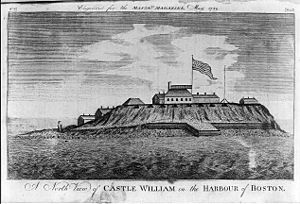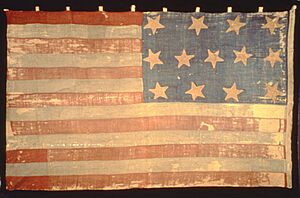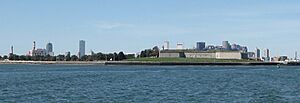Fort Independence (Massachusetts) facts for kids
Quick facts for kids |
|
|
Fort Independence
|
|
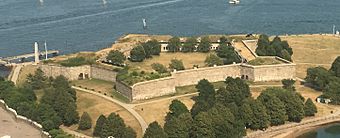 |
|
| Location | Castle Island, Boston, Massachusetts |
|---|---|
| Area | 15 acres (6.1 ha) |
| Built | 1634 |
| NRHP reference No. | 70000921 |
| Added to NRHP | October 15, 1970 |
Fort Independence is a strong stone fort located on Castle Island in Boston, Massachusetts. It was built to defend Boston Harbor. This fort is one of the oldest places in the United States that has been continuously used for defense since English settlers arrived. The very first fort, called "The Castle," was built here in 1634. It was rebuilt several times. Around 1692, a bigger fort called Castle William took its place.
During the American Revolution, the British left the fort. Americans then renamed it Fort Adams, and later Fort Independence. The stone fort you see today was built between 1833 and 1851. Now, it's a state park where people can visit and learn about history. Sometimes, it even fires cannons for special events! Fort Independence was added to the National Register of Historic Places in 1970.
Fort Independence: A Historic Boston Fort
Early Forts: Castle William
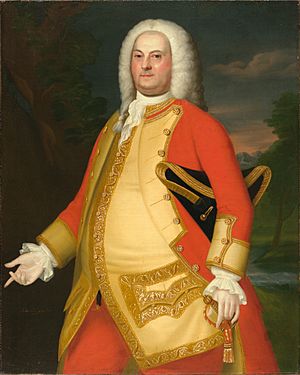
The spot where Fort Independence stands has had forts since 1634. The first fort on Castle Island was built after Governor John Winthrop visited. He and his council helped pay for it. Deputy Governor Roger Ludlow and Captain John Mason oversaw the building. They made a "castle with mud walls" using oyster shells and lime. Cannons were placed there to protect Boston from sea attacks. Captain Nicholas Simpkins was the first commander in 1634.
Rebuilding and Expansion
The first fort soon needed repairs. It was rebuilt in 1644 after a French warship caused alarm in the harbor. This new fort was made of pine logs, stone, and earth. It had 10-foot walls around a 50-foot square area. It held six cannons and three smaller guns. Captain Richard Davenport commanded the fort from 1645 until 1665. Sadly, he was struck by lightning and died. Captain Roger Clap took over from 1665 to 1686.
On March 21, 1673, the fort burned down. It was rebuilt the next year with stone. This fort had 38 large guns and 16 smaller ones. It also had a water battery with six guns. In 1689, Governor Edmund Andros was held at the fort. He was sent to England after King James II was replaced by King William III.
In 1692, the fort was renamed "Castle William" to honor King William. It was rebuilt again with 54 cannons of different sizes. From 1701 to 1703, the fort grew even more. Wolfgang William Romer, a chief engineer for the British, designed the changes. The fort's cannons almost doubled to 100 guns. In 1740, a fifth section was added, holding 20 very large cannons.
Castle William and the American Revolution
Before the American Revolution, Castle William was a safe place for British officials. They would go there during times of trouble in Boston. For example, after the Stamp Act in 1765 and the Boston Massacre in 1770, British leaders and soldiers took shelter in the fort. In September 1765, the special stamps from the Stamp Act were even kept at the fort.
When the American Revolution began in 1775, American forces started the Siege of Boston. British forces made Castle William their main stronghold. But when George Washington's Continental Army fortified Dorchester Heights, Castle William was in danger. The British left Boston in March 1776. Before leaving Castle William, they set the fort on fire. They wanted to damage it and its weapons as much as possible.
During the Revolutionary War, another fort called Fort Independence was built in Hull, Massachusetts. In 1797, the name "Fort Independence" was given to the former Castle William. The fort in Hull was later named Fort Revere.
Fort Adams: A New American Name
American forces rebuilt the fort in 1776 and renamed it Fort Adams. In 1785, the Massachusetts government used the fort as a prison. It served this purpose until 1805.
The fort was renamed Fort Independence in 1799. President John Adams attended the ceremony. The next year, the fort and island were given to the United States government. The fort was rebuilt and made larger between 1800 and 1803. This was part of the first plan for US coastal defenses. Military engineer Jean Foncin designed the changes.
A report from 1811 described the fort as a five-sided building with stone sections. It had 42 heavy cannons and two extra batteries for six more guns. During the War of 1812, British ships captured American vessels in Massachusetts Bay. However, they never attacked Boston Harbor. This was because Fort Independence was too strong.
The Current Fort Independence
Work on the fort you see today began in 1833. This was part of the third plan for US coastal defenses. Colonel Sylvanus Thayer, a top military engineer, supervised the work. The new fort had walls 30 feet high and 5.5 feet thick. It was mostly built from granite from Rockport, Massachusetts. It was mostly finished by 1848, but repairs continued until 1861.
Fort Independence During the Civil War
During the American Civil War, Fort Independence was very strong. It held 96 cannons. Some were 15-inch Rodman guns. These could fire a 450-pound shot over 3 miles! A small part of the old Castle William's brick structure is still inside the fort. But it is covered by the newer stone work.
When the Civil War started in 1861, soldiers from Massachusetts were stationed at Fort Independence. They got the fort ready and trained in military drills. These soldiers later formed the core of the 24th Regiment Massachusetts Volunteer Infantry. At least two other infantry regiments also trained at Fort Independence during the Civil War. These were the 11th Massachusetts and the 13th Massachusetts.
Later Years and Park Creation
After the Civil War, Fort Independence was used less and less. A larger fort, Fort Warren, had been built. It was also designed by Sylvanus Thayer. In the 1880s, a landscape architect named Frederick Law Olmsted designed parks in Boston. He wanted to connect Castle Island to these parks. This plan was not fully built.
However, Boston did a big project in the 1890s. They wanted to make the area around Fort Independence like a park. In 1890, the US government gave Castle Island (but not the fort) to Massachusetts. Boston started filling in the marsh areas that separated Castle Island from South Boston. The goal was to create green spaces and walking paths. This work finished in the 1920s. After that, Castle Island was no longer an island. The US government gave the fort to the city of Boston in 1908.
The US government briefly took back Castle Island in 1898 during the Spanish American War. But it was quickly returned to Boston in 1899. The military took control of Fort Independence again during World War I and World War II. Anti-aircraft guns were added. In World War I, the fort stored small arms ammunition. In World War II, the Navy used it to de-magnetize ship hulls. After both wars, the fort was given back to Boston.
In 1962, the US government officially gave Castle Island and Fort Independence to Massachusetts forever. Now, the Massachusetts Department of Conservation and Recreation and a group called the Castle Island Association take care of it. Fun fact: Fort Independence has never fired a shot in a real battle!
Edgar Allan Poe and a Historic Story
Outside the fort's west side, there is a monument. It marks the grave of Lieutenant Robert F. Massie. He died in a sword duel on December 25, 1817. He fought Lieutenant Gustavus Drane. A storyteller named Edward Rowe Snow said that Massie was very popular with the soldiers. He claimed they walled up his killer inside the fort.
Edgar Allan Poe was a famous writer. He served at Fort Independence in 1827. People say he was inspired by this story to write his famous short story, "The Cask of Amontillado".
However, the legend is not completely true. The duel did happen. But Lieutenant Drane was not killed by the soldiers. He continued his military career and became a captain. He died in 1846 while still serving. After World War II, Lieutenant Massie's remains were moved to the Fort Devens Cemetery.




